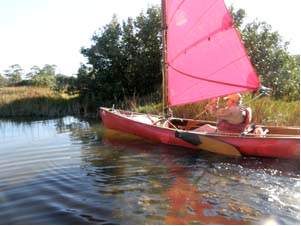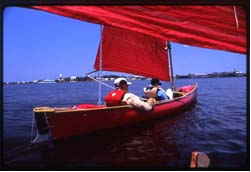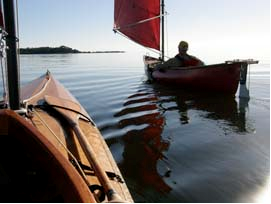| Language and Social Media |  |
 |
 |
 |
Choosing a Hull for Monohull Canoe Sailing
...and evaluating the hull you have
Originally published in www.canoesailingmagazine.com
Almost anything can be made to sail, including to windward---but what will satisfy you? What do you want to do with your sailing canoe? Are you new to sailing, a sailing purist, or maybe an ex-racing sailor?
Do you canoe? Much? What's your canoe history? Fishing saltwater grass flats? Pan fish in Midwestern lakes? Or are you a pond floating naturalist, maybe a turtle watcher?
What do you think your ratio of sailing to paddling will be?
* * *
 Most of the time beam, rocker, and full ends help sailing.
Most of the time beam, rocker, and full ends help sailing.
The good news with a canoe you already have is they're often wide enough. Lack of beam is seldom a problem for the one you could have, and if you buy a new or old one, beam shouldn't be a problem since you know you're thinking about sailing.
How wide? Think paddling. A 38 or 40 inch wide canoe can be a very powerful sailer, but even skilled single blade paddlers can cock an eyebrow at boats wider than 40 inches.
Our solo Bufflehead is 33 inches wide. Its predecessor, built on a Dave Yost drawn Bell Starfire hull, is 34 inches. These are near what is thought, these days, to be about the limit for a double-bladed paddle, although long double paddles moving three feet wide boats were ubiquitous at canoe clubs in the late 19th and early 20th centuries.
A sailing paddler of great experience with double paddles said if paddling were to be more than half of his boat's use, he'd think about a canoe 28 to 31 inches wide. Usually---if the boat is a good sailer---as the boat gets wider, sailing becomes more frequent, even for a dedicated paddler. And, anyway, as we age sailing seems more the default choice.
Rocker, or a straight bottom? Does a long, shallow keel help?
 About the only problem with rocker for sailing is there's seldom enough of it. It's as consequential as beam.
Without enough rocker, the agility and controllability that mark a good sailing canoe won't exist, even with her
lightly loaded. It lets us pivot over our buoyancy, and aids control in rough conditions (the other white water).
Tacking, and control when gybing, too, are helped when the ends are out, or nearly out of the water.
About the only problem with rocker for sailing is there's seldom enough of it. It's as consequential as beam.
Without enough rocker, the agility and controllability that mark a good sailing canoe won't exist, even with her
lightly loaded. It lets us pivot over our buoyancy, and aids control in rough conditions (the other white water).
Tacking, and control when gybing, too, are helped when the ends are out, or nearly out of the water.
Not that we can't adapt, that we can't cope with nearly anything, but why should we? Even most Harley riders have given up rigid rear wheel mounts for suspensions.
Some canoe sailors follow American Canoe Association or Open Canoe Group sailing canoe racing rules. To turn, they heel their flat, barely rockered boats, getting the ends out of the water, as a single blade paddler does. Many of these sailors steer with a paddle because of inertia from the old racing rules. But most of us want an easily controlled, agile boat, forgiving and recovering quickly from our occasional clumsiness.
If a modern forty five foot, six ton ocean racer can be easy on the helm and steer precisely, or that even a 1939, forty five foot, twenty four ton gaff cutter, seven feet deep can be fun to sail, light on the tiller, a fast bruiser off shore, yet a ballerina in harbor (as Laurent Giles's Dyarchy was believed to be), why can't we do as well with our sailing canoes?
A shallow, full length keel is almost always a hindrance. It's there for structural reasons, not boat performance. (Ashore it's handy for a skid, sometimes, when its weight is balanced on it.)
Full ends versus fine and hollow. Most paddling craft are more efficient when moving below hull speed, maybe two thirds to three quarters of it, so fine ended hulls with hollow waterlines are common among old and new canoes, and many touring kayaks.
But for sailing, we'll exceed hull speed off the wind---we seldom lack power on that point---and maybe on the wind, too. So we want full ended boats without hollow waterlines. Our bow should resist pearling (submarining) when going too fast downswell. Our stern shouldn't try to suck itself into a wet trench above hull speed. We want the water to separate cleanly, with the shape and buoyancy preventing squat and encouraging lift. Yes, we pay a penalty when paddling, and maybe with light air sailing, but to me the penalty is miniscule, particularly as over the years I paddle less and sail more.
* * *
 While anything can be made to sail with a big, clean and powerful rig over a deep and shapely foil---carefully selected
hull characteristics do it easier. A boat can have inauspicious beginnings and still sail well. You could have a molded
floppy boat of decent shape, that with an added prodding and supporting frame, would be stiff enough to perform
acceptably for many sailors.
While anything can be made to sail with a big, clean and powerful rig over a deep and shapely foil---carefully selected
hull characteristics do it easier. A boat can have inauspicious beginnings and still sail well. You could have a molded
floppy boat of decent shape, that with an added prodding and supporting frame, would be stiff enough to perform
acceptably for many sailors.
Rigs can be slapped on any old hull, but the rig and gear should try to counter ineffective hull qualities. A sailing machine can improve when thought of as a unified, integrated whole of hull, rig, leeboard, rudder, and you, where you put your mass.
Try to add sailing components which fit your hull. A big wide hull can use a big, tall rig. If it has a straight bottom with a long extruded keel, a powerful, foiled rudder will help, but you needn't bother on a short, white water boat. I don't think you'd use eighteen inch low sidewall tires and mag wheels off your Ferrari on your Farmall (tractor) , and I doubt you'd put its tires on your Ferrari, either end.
The shape and responses of an "expedition" paddling boat's hull are different than an expedition sailing canoe's. An expedition paddling canoe won't necessarily make a good expedition sailing canoe.
What will satisfy you? Read, research, and analyse. While now you might think catching fish is your goal, be aware the promise of sailing is catching by itself, and has joy of its own.
One more thing. Please put as much thought and effort into your flotation, regardless of your boat's origin, as you put into its sailing equipment.